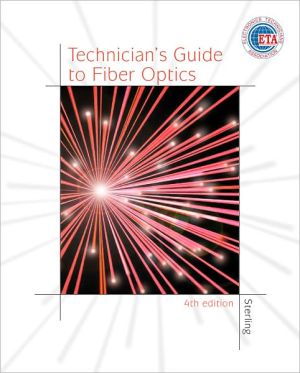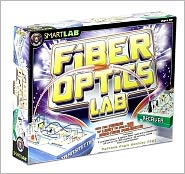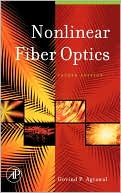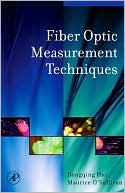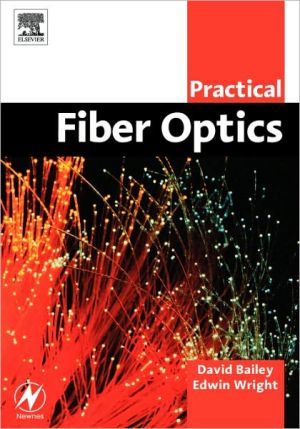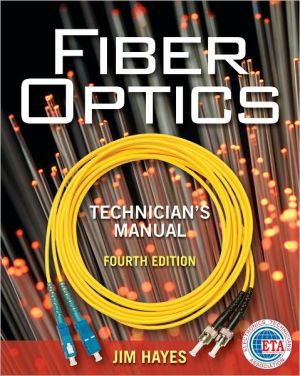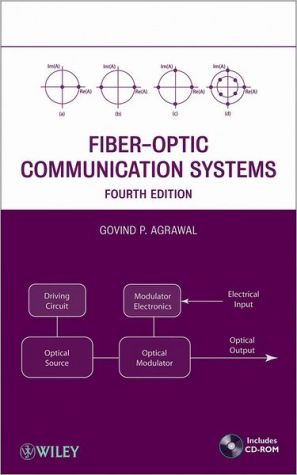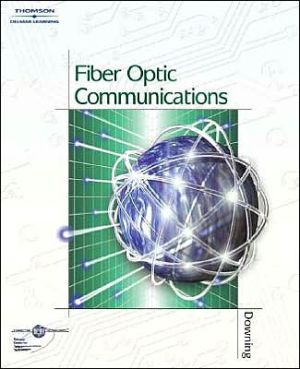Technician's Guide to Fiber Optics, 4E
An excellent primer for students beginning to study the subject, this current edition provides a practical, real-world perspective on the fundamentals of fiber optic technology and optical communications. It examines the reasons that optical fibers are the preferred communications medium, surpassing copper wire in all performance measures. A thorough explanation of how fibers work is offered, as well as useful coverage of other related optical components and how those components fit into...
Search in google:
An excellent primer for students beginning to study the subject, there is equal emphasis on both the theory of fiber and its applications in communications. There is a thorough explanation and description of how fiber differs from copper wire as well as a useful perspective on how fiber is used. Booknews Describes the advantages of fiber over copper, the basic components of a fiber-optic system, and how fiber-optics systems are put together. The third edition expands coverage to dense wavelength- division multiplexers and vertical-cavity surface-emitting lasers. Annotation c. Book News, Inc., Portland, OR (booknews.com)
\ \ Chapter 1: The Communications Revolution\ THE INFORMATION AGE\ America, it has been said, is entering the information age, which also means the electronic age. The information age uses electronics to perform the four functions of information processing.\ 1. Gathering information\ 2. Storing information\ 3. Manipulating and analyzing information\ 4. Moving information from one place to another\ The tools of the age are fairly new: computers, electronic offices, a complex telephone network, satellites, information networks and databases, cable television, and so forth. If you look, the evidence of the age surrounds you. The information-services industry has been growing at a rate of 15% a year and shows no signs of slowing down.\ In short, America-and much of the rest of the world-is quickly becoming a huge network wired together by electronics. As easily as you can telephone from New York to San Francisco, you can send computer data across the country. In offices, large and small computers and other electronic equipment are connected into networks. Engineers use computers to work to design new computers. Home and personal computers abound. This book was written on a computer. It is even possible to write, produce, and publish a book without ever touching a piece of paper. All the information in the book is moved electronically from the writer's word processor to the printer's typesetting and printing equipment.\ The following facts give some perspective to the importance of electronics in modern life.\ \ In 1988, there were an estimated 165 million telephones in the United States,compared to only 39 million in 1950. In addition, the services provided by your telephone company are much more sophisticated.\ From 1950 to 1981, the number of miles of wire in the telephone system increased from 147 million to 1.1 billion.\ In 1990, there were an estimated 5 million miles of fiber in the U.S. telephone system. This will increase to 15 million by the year 2000. Each fiber has the capacity to replace several copper cables.\ In 1989, an estimated 10 million personal computers were sold to businesses and consumers in the U.S. The personal computer did not exist in 1976; today it is commonplace and essential office and engineering equipment.\ More than 1500 computer databases are available from which you can obtain information, using a personal computer and the public telephone network.\ FAXes are replacing letters in many business situations.\ The first fiber-optic telephone system, installed in 1977, operated at 44.7 Mbps and was capable of carrying 672 voices simultaneously. Today, Sonet, which is a standardized system for optical telephony, offers a top speed of 10 Gbp-sover 200 times faster than the first optical system. Faster speeds are planned but are not yet approved and standardized because electronic components are not readily available.\ \ The point is that all these represent sources of information and the means of tying them together. The information may be a telephone call to a friend or the design of a new widget. Important to the growing amount of information is the means of moving it from one place to another. This movement may be a telephone call across the country or from one office to another office a couple of doors away. Telephone companies increasingly use the same digital techniques to send your voice and computer data. Surprisingly, your voice becomes more like computer data: It is converted into digital pulses-numbers-just like computer data. By making this conversion, the telephone company transmits your telephone call with greater fidelity and reliability. Digital transmission systemsrather than traditional analog systems-are used in most new telephone systems. One study estimates that 34% of telephone central offices used digital transmission equipment in 1984. By 1994, this percentage will increase to 82%. Fiber optics is exceptionally suited to the requirements of digital telecommunications. Coupled with the need to move information is the need to move it faster, more efficiently, more reliably, and less expensively. Fiber optics fills these needs.\ THE WIRING OF AMERICA\ The oldest and most obvious example of the wiring of the United States is, of course, the telephone network. At one time, the network carried voices almost exclusively, whereas it now carries voice, computer data, electronic mail, and video pictures.\ Cable television is another example. It offers the possibility of interactive television. The cable will not only bring you television, but it will allow you to respond to opinion polls, shop at home, make restaurant and airline reservations, and do many other things. In short, interactive cable TV will become two-way communication. Rather than simply provide television broadcasts to your home, it will allow you to send information from your home. Such systems have been tested experimentally in the United States, Europe, and Japan, and some experiments used fiber optics. A fiber-optic cable television system announced in 1991 to be built in Queens, New York, will be capable of providing over 150 channels to a household.\ Home banking and financial services, offered in some cities by major banks, are also made possible by the wiring of America. From a personal computer or terminal in your home, you can check account balances, transfer funds between accounts, pay bills, buy stocks and bonds, add to money market accounts, and so forth.\ Another area of wiring where computers have invaded is the office. Word processors have replaced secretaries' typewriters. Computers have replaced the accountant's balance books, the manager's spreadsheet, and the engineer's drafting table. Furthermore, a need exists to allow electronic devices to communicate with each other and with the world outside the office. Local area networks (LANs) fill this need by allowing electronic equipment to be tied together electronically. In addition, many networks also connect to the public telephone network. Again, fiber optics has a role to play in the modern office by providing an efficient transmission medium for networked equipment.\ Factories, too, now use electronics extensively. Computers control and monitor activities, and robots perform monotonous, dangerous, or tedious tasks. In advanced factories, various activities are tied together electronically so that all operate harmoniously. But the electrical noise caused by the high-powered machinery can interfere with the control signals. Switching of electrical loads and operating equipment such as arc welders or drills produces electrical noise transients. Because of this noise, a great deal of care, such as shielding cables or separating them from power line sources of noise, must be taken to protect the signals on control lines. Because fibers are immune to electrical noise, fiber optics is a good candidate for the factory.\ TELECOMMUNICATIONS AND THE COMPUTER\ Until a few years ago, a clear distinction existed between what was part of the telephone system and what was a computer system. Telephone companies, for example, were legally forbidden to compete in the computer marketplace. Today, the distinction, if it still exists, has blurred considerably. Computers send data over telephone lines. Telephone systems turn your voice into computerlike data before transmitting it. Telephone and computer companies now often compete in the same market....
PrefaceCh. 1The Communications Revolution2Ch. 2Information Transmission12Ch. 3Fiber Optics as a Communications Medium: Its Advantages24Ch. 4Light33Ch. 5The Optical Fiber44Ch. 6Fiber Characteristics58Ch. 7Fiber-Optic Cables72Ch. 8Sources86Ch. 9Detectors104Ch. 10Transmitters and Receivers121Ch. 11Connectors and Splices135Ch. 12Couplers172Ch. 13The Fiber-Optic Link190Ch. 14Fiber-Optic Cable Installation and Hardware199Ch. 15Fiber-Optic Systems and Applications212Ch. 16Introduction to Test and Other Equipment241Glossary256Index265
\ BooknewsDescribes the advantages of fiber over copper, the basic components of a fiber-optic system, and how fiber-optics systems are put together. The third edition expands coverage to dense wavelength- division multiplexers and vertical-cavity surface-emitting lasers. Annotation c. Book News, Inc., Portland, OR (booknews.com)\ \
